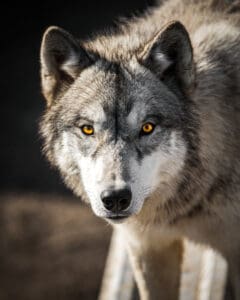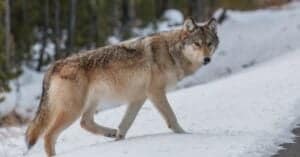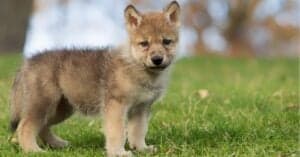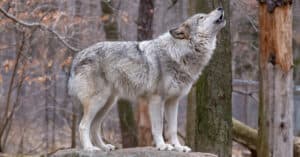Wolf Teeth: Everything You Need to Know
Wolves are known the world over as the bad guys in children’s stories, hunters of deer and elk, and relatives of our beloved dogs. There are over 30 species of wolf, the most famous (and recognizable) of which is the gray, or timber, wolf. Gray wolves (Canis lupus) are the largest extant member of the Canidae family. They are characterized by their erect, ovoid ears, long fluffy tails, long snout, and narrow, compact body.
In addition to their eyes and ears, wolves also have a mouthful of large teeth (the better to eat their prey with). Here, we’ll discover everything there is to know about wolf teeth, what they use them for, and how to tell a wolf’s age from its teeth. Then, we’ll explore the teeth of the extinct dire wolf, and how they differ from the teeth of modern wolves.

Milk teeth
Wolves are born blind, deaf, and toothless. Pups subsist entirely on their mother’s milk for the first two weeks of life. At that point, their deciduous (milk) teeth start to come in. The pups continue to drink milk until they are a couple of months old, but are fully weaned onto meat by the time they’ve reached three months. By this time, they have full set of deciduous teeth.
Adult teeth
As wolves grow, their permanent teeth push out their baby teeth. By the time they’re seven months old, they usually have all of their adult teeth. Adult wolves have 42 teeth in total; 12 incisors, four canines, 16 premolars, and ten molars. Each tooth type performs a different function.

Satirus/Shutterstock.com
Incisors
Wolves have 12 incisors; six on the top and six on the bottom. These teeth are smaller than the canines, with the upper incisors bigger than the lower ones. The upper corner incisors are the biggest, and most resemble the canines. There is a small gap between these upper corner incisors and the canines.
Wolves use their incisors to eat small morsels of food, and to scrape meat from bones. They also use them to groom themselves and each other. They use these small front teeth to chew bugs and debris from their fur, and to scratch itches. The incisors are essential for grabbing bites of food, both from living animals and carrion.
Canines
The most noticeable teeth in the wolf’s mouth are the canine teeth. These are large, conical, sharp, and recurved towards the skull. Canine teeth can grow up to 2.5 inches long, and are used principally for holding onto prey once caught.
Premolars
After the canines, the next teeth in a wolf’s mouth are the premolars. The first premolar is very small and conical. The upper second and third premolars are narrow from side to side, but long from front to back. They have three sharp crowns and, when fitted together with the similarly shaped bottom three premolars, act like scissors to cut up meat. The upper fourth premolar is one of the largest teeth in a wolf’s mouth, and features three huge, razor sharp crowns. This tooth scissors against the first lower molar.
Molars
Wolves have ten molars, with only four in the upper mouth. These upper molars are very small, and are used only for grinding up food, not for cutting. The same can be said for the second and third molars on the bottom, though they are not quite as undersized as the upper first molar.
What Do Wolves Use Their Teeth For?
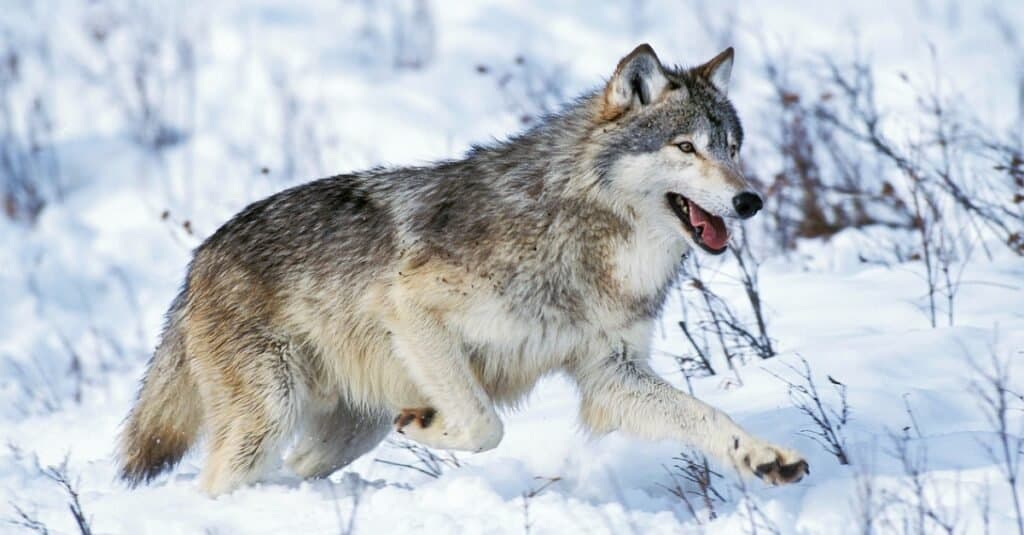
Wolves are mostly carnivorous (they won’t say no to a nice fruit or vegetable, if it presents itself) and eat every part of their prey. Because wolves eat the meat, bones, cartilage, and everything else, they need teeth that can not only cut through meat, but crush bone.
It all starts with the canines. When a wolf latches on to a prey animal, the canines focus all of the wolf’s 1,500 lbf bite force, holding the creature tight in the wolf’s grip. Wolves most often kill by gripping the throat or the nose until the prey suffocates, so it’s important that they maintain a good hold.
Once the wolves have something to eat, they gorge themselves. Their sharp premolars and molars are called carnassials, and are used to shear meat away from carcasses. These teeth occlude against each other on the top and bottom the same way a pair of scissors does, cutting meat and re-sharpening as they go.
The back teeth, the molars, are much flatter than the carnassials, and are vital for chewing up tougher parts of the animal. Animals like cats, who eat only the meat of the prey, not the hard parts, don’t have these flatter, grinding surfaces. But wolves don’t let anything go to waste, and as such have a mouth full of different tools.
How to Tell A Wolf’s Age From Its Teeth
Wolves use their teeth for everything, and by the time they’ve reached 5-6 years of age, their teeth begin to wear down. The more worn a wolf’s teeth, the older it is. Wolves over eight years of age often have only nubs for canines, and can no longer effectively hunt. Instead, they rely on fellow pack members to provide food for them. Older wolves often have missing incisors too, as these teeth break or fall out with age.
Ancient Wolf Teeth

Aunt Spray/Shutterstock.com
Modern wolves have a larger, extinct relative; the dire wolf. Dire wolves (Aenocyon dirus) lived in North America until about 10,000 years ago. They exceeded the size of today’s gray wolves, and had mouths to match. Dire wolves were stockier than their modern cousins, and their teeth were even bigger and heavier. Like modern wolves, they had 42 teeth, though theirs were much larger. Their premolars and molars especially were robustly built, and are thought to have been used to crush through thick bones.
More from A-Z Animals
Wolves are known the world over as the bad guys in children’s stories, hunters of deer and elk, and relatives of our beloved dogs. There are over 30 species of wolf, the most famous (and recognizable) of which is the gray, or timber, wolf. Gray wolves (Canis lupus) are the largest extant member of the Canidae family. They are characterized by their erect, ovoid ears, long fluffy tails, long snout, and narrow, compact body.
In addition to their eyes and ears, wolves also have a mouthful of large teeth (the better to eat their prey with). Here, we’ll discover everything there is to know about wolf teeth, what they use them for, and how to tell a wolf’s age from its teeth. Then, we’ll explore the teeth of the extinct dire wolf, and how they differ from the teeth of modern wolves.

Milk teeth
Wolves are born blind, deaf, and toothless. Pups subsist entirely on their mother’s milk for the first two weeks of life. At that point, their deciduous (milk) teeth start to come in. The pups continue to drink milk until they are a couple of months old, but are fully weaned onto meat by the time they’ve reached three months. By this time, they have full set of deciduous teeth.
Adult teeth
As wolves grow, their permanent teeth push out their baby teeth. By the time they’re seven months old, they usually have all of their adult teeth. Adult wolves have 42 teeth in total; 12 incisors, four canines, 16 premolars, and ten molars. Each tooth type performs a different function.

Satirus/Shutterstock.com
Incisors
Wolves have 12 incisors; six on the top and six on the bottom. These teeth are smaller than the canines, with the upper incisors bigger than the lower ones. The upper corner incisors are the biggest, and most resemble the canines. There is a small gap between these upper corner incisors and the canines.
Wolves use their incisors to eat small morsels of food, and to scrape meat from bones. They also use them to groom themselves and each other. They use these small front teeth to chew bugs and debris from their fur, and to scratch itches. The incisors are essential for grabbing bites of food, both from living animals and carrion.
Canines
The most noticeable teeth in the wolf’s mouth are the canine teeth. These are large, conical, sharp, and recurved towards the skull. Canine teeth can grow up to 2.5 inches long, and are used principally for holding onto prey once caught.
Premolars
After the canines, the next teeth in a wolf’s mouth are the premolars. The first premolar is very small and conical. The upper second and third premolars are narrow from side to side, but long from front to back. They have three sharp crowns and, when fitted together with the similarly shaped bottom three premolars, act like scissors to cut up meat. The upper fourth premolar is one of the largest teeth in a wolf’s mouth, and features three huge, razor sharp crowns. This tooth scissors against the first lower molar.
Molars
Wolves have ten molars, with only four in the upper mouth. These upper molars are very small, and are used only for grinding up food, not for cutting. The same can be said for the second and third molars on the bottom, though they are not quite as undersized as the upper first molar.
What Do Wolves Use Their Teeth For?

Wolves are mostly carnivorous (they won’t say no to a nice fruit or vegetable, if it presents itself) and eat every part of their prey. Because wolves eat the meat, bones, cartilage, and everything else, they need teeth that can not only cut through meat, but crush bone.
It all starts with the canines. When a wolf latches on to a prey animal, the canines focus all of the wolf’s 1,500 lbf bite force, holding the creature tight in the wolf’s grip. Wolves most often kill by gripping the throat or the nose until the prey suffocates, so it’s important that they maintain a good hold.
Once the wolves have something to eat, they gorge themselves. Their sharp premolars and molars are called carnassials, and are used to shear meat away from carcasses. These teeth occlude against each other on the top and bottom the same way a pair of scissors does, cutting meat and re-sharpening as they go.
The back teeth, the molars, are much flatter than the carnassials, and are vital for chewing up tougher parts of the animal. Animals like cats, who eat only the meat of the prey, not the hard parts, don’t have these flatter, grinding surfaces. But wolves don’t let anything go to waste, and as such have a mouth full of different tools.
How to Tell A Wolf’s Age From Its Teeth
Wolves use their teeth for everything, and by the time they’ve reached 5-6 years of age, their teeth begin to wear down. The more worn a wolf’s teeth, the older it is. Wolves over eight years of age often have only nubs for canines, and can no longer effectively hunt. Instead, they rely on fellow pack members to provide food for them. Older wolves often have missing incisors too, as these teeth break or fall out with age.
Ancient Wolf Teeth

Aunt Spray/Shutterstock.com
Modern wolves have a larger, extinct relative; the dire wolf. Dire wolves (Aenocyon dirus) lived in North America until about 10,000 years ago. They exceeded the size of today’s gray wolves, and had mouths to match. Dire wolves were stockier than their modern cousins, and their teeth were even bigger and heavier. Like modern wolves, they had 42 teeth, though theirs were much larger. Their premolars and molars especially were robustly built, and are thought to have been used to crush through thick bones.

